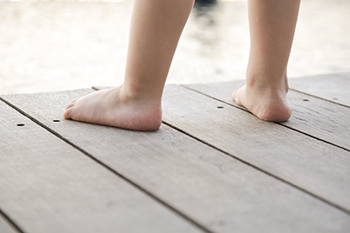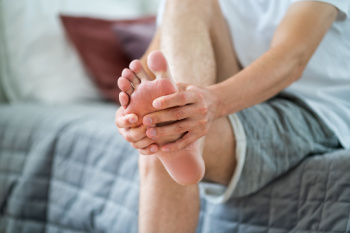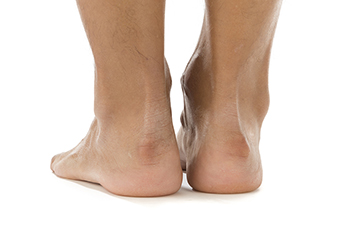159 North 3rd Street
Macclenny, Florida 32063

Foot pronation is the natural inward and outward movement of the foot while walking or running. In some cases, it can lead to over-pronation, where the foot excessively rolls inward, which affects gait and weight distribution. Overpronation may begin in childhood as a result of underdeveloped arches, or develop in adulthood due to arch collapse. Causes include genetics, foot deformities, and injuries. Obesity, and conditions like diabetes or arthritis, are other factors in developing pronation problems. Symptoms include pain, swelling, and related foot disorders such as plantar fasciitis or shin splints. Diagnosis involves examination, gait analysis, and imaging tests conducted by a podiatrist. If you have developed signs of overpronation, it is suggested that you make an appointment with a podiatrist for an exam and treatment options that are best for you.
If you have any concerns about your feet, contact Dr. John L. Coleman from Florida. Our doctor can provide the care you need to keep you pain-free and on your feet.
Biomechanics in Podiatry
Podiatric biomechanics is a particular sector of specialty podiatry with licensed practitioners who are trained to diagnose and treat conditions affecting the foot, ankle and lower leg. Biomechanics deals with the forces that act against the body, causing an interference with the biological structures. It focuses on the movement of the ankle, the foot and the forces that interact with them.
A History of Biomechanics
Modern technological improvements are based on past theories and therapeutic processes that provide a better understanding of podiatric concepts for biomechanics. Computers can provide accurate information about the forces and patterns of the feet and lower legs.
Understanding biomechanics of the feet can help improve and eliminate pain, stopping further stress to the foot.
If you have any questions please feel free to contact our office located in Macclenny, FL . We offer the newest diagnostic and treatment technologies for all your foot and ankle needs.

Gout pain, a form of inflammatory arthritis, manifests as intense discomfort characterized by sudden, severe joint pain, typically affecting the big toe. Described as excruciating, stabbing, or throbbing, gout pain often strikes unexpectedly and can be debilitating, making even the slightest movement agonizing. The affected joint becomes swollen, tender, and warm to the touch, with the pain reaching its peak within a few hours. Gout attacks frequently occur at night, disrupting sleep and causing considerable distress. Beyond the big toe, gout can also affect joints such as the ankles, knees, wrists, and fingers, causing similar symptoms. The pain associated with gout can persist for days or weeks, gradually subsiding with proper treatment and management. Factors like diet, lifestyle choices, genetics, and underlying health conditions can influence the frequency and severity of gout attacks. Recognizing the distinct sensation of gout pain is essential for timely diagnosis and effective management. If you have had one or more gout attacks, it is suggested that you are under the care of a podiatrist who can help you manage this condition.
Gout is a painful condition that can be treated. If you are seeking treatment, contact Dr. John L. Coleman from Florida. Our doctor will treat your foot and ankle needs.
What Is Gout?
Gout is a form of arthritis that is characterized by sudden, severe attacks of pain, redness, and tenderness in the joints. The condition usually affects the joint at the base of the big toe. A gout attack can occur at any random time, such as the middle of the night while you are asleep.
Symptoms
Risk Factors
Prior to visiting your podiatrist to receive treatment for gout, there are a few things you should do beforehand. If you have gout you should write down your symptoms--including when they started and how often you experience them, important medical information you may have, and any questions you may have. Writing down these three things will help your podiatrist in assessing your specific situation so that he or she may provide the best route of treatment for you.
If you have any questions, please feel free to contact our office located in Macclenny, FL . We offer the newest diagnostic and treatment technologies for all your foot care needs.

Haglund's deformity, an abnormality affecting the foot bone and soft tissues, can be recognized by a bony growth at the back of the heel, where the Achilles tendon is located. This enlargement, often referred to as a pump bump, can result in irritation of the adjacent soft tissue when it rubs against rigid shoes. Haglund’s deformity can lead to bursitis, a painful inflammation of the fluid-filled sac between the tendon and the bone. While this deformity can develop in anyone, it is most commonly observed in individuals who wear stiff, closed-heel shoes, particularly pump-style high heels. Several risk factors increase susceptibility to Haglund's deformity, including a high foot arch, a tight Achilles tendon, or a tendency to walk on the outside of the heel. Symptoms can include a noticeable bony bump on the back of the heel, severe pain where the Achilles tendon attaches to the heel, swelling in the bursa, and redness near the inflamed tissue. If you suspect you have Haglund's deformity, it is suggested that you schedule an appointment with a podiatrist for an evaluation and suggested treatment options.
Many people suffer from bouts of heel pain. For more information, contact Dr. John L. Coleman of Florida. Our doctor can provide the care you need to keep you pain-free and on your feet.
Causes of Heel Pain
Heel pain is often associated with plantar fasciitis. The plantar fascia is a band of tissues that extends along the bottom of the foot. A rip or tear in this ligament can cause inflammation of the tissue.
Achilles tendonitis is another cause of heel pain. Inflammation of the Achilles tendon will cause pain from fractures and muscle tearing. Lack of flexibility is also another symptom.
Heel spurs are another cause of pain. When the tissues of the plantar fascia undergo a great deal of stress, it can lead to ligament separation from the heel bone, causing heel spurs.
Why Might Heel Pain Occur?
Treatments
Heel pain should be treated as soon as possible for immediate results. Keeping your feet in a stress-free environment will help. If you suffer from Achilles tendonitis or plantar fasciitis, applying ice will reduce the swelling. Stretching before an exercise like running will help the muscles. Using all these tips will help make heel pain a condition of the past.
If you have any questions please contact our office located in Macclenny, FL . We offer the newest diagnostic and treatment technologies for all your foot and ankle needs.

When grappling with the discomfort of ingrown toenails, partial and total nail avulsion emerges as a viable solution. Partial nail avulsion involves the removal of a portion of the affected nail, addressing the ingrown edge, and providing relief. This procedure aims to eliminate the problematic segment while preserving the overall integrity of the nail. Conversely, total nail avulsion involves completely removing the toenail, offering a more comprehensive approach to severe or recurrent ingrown toenails. Both procedures are typically performed under local anesthesia to minimize discomfort. Proper postoperative care is vital to promote healing and prevent complications following avulsion. Understanding the differences between partial and total nail avulsion allows individuals to make informed decisions in collaboration with podiatrists. If you have developed an ingrown toenail, it is strongly suggested that you are under the care of a podiatrist who can determine if one of these types of surgery is right for you.
Ingrown toenails may initially present themselves as a minor discomfort, but they may progress into an infection in the skin without proper treatment. For more information about ingrown toenails, contact Dr. John L. Coleman of Florida. Our doctor can provide the care you need to keep you pain-free and on your feet.
Ingrown Toenails
Ingrown toenails are caused when the corner or side of a toenail grows into the soft flesh surrounding it. They often result in redness, swelling, pain, and in some cases, infection. This condition typically affects the big toe and may recur if it is not treated properly.
Causes
You are more likely to develop an ingrown toenail if you are obese, have diabetes, arthritis, or have any fungal infection in your nails. Additionally, people who have foot or toe deformities are at a higher risk of developing an ingrown toenail.
Symptoms
Some symptoms of ingrown toenails are redness, swelling, and pain. In rare cases, there may be a yellowish drainage coming from the nail.
Treatment
Ignoring an ingrown toenail can have serious complications. Infections of the nail border can progress to a deeper soft-tissue infection, which can then turn into a bone infection. You should always speak with your podiatrist if you suspect you have an ingrown toenail, especially if you have diabetes or poor circulation.
If you have any questions, please feel free to contact our office located in Macclenny, FL . We offer the newest diagnostic and treatment technologies for all your foot care needs.